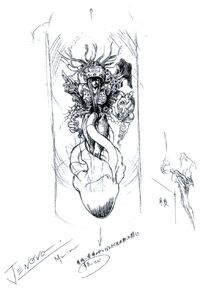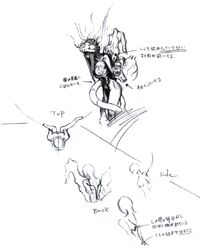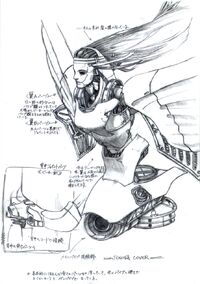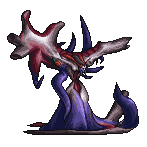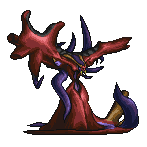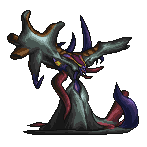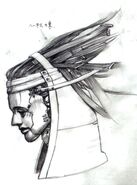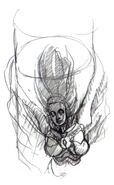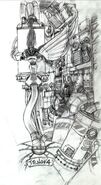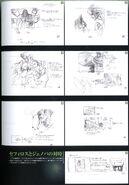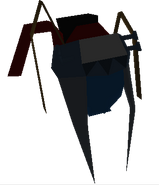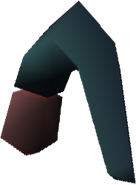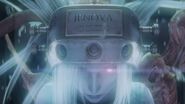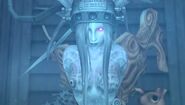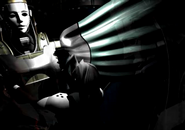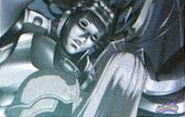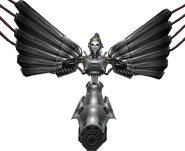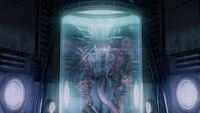
Jenova at the Nibel Reactor, in an enhanced visual flashback from Final Fantasy VII: Advent Children.
Jenova was a Calamity that fell from the sky a long, long time ago, and tried to destroy the planet...
Jenova (ジェノバ, Jenoba?) is an extraterrestrial life-form in Final Fantasy VII that also appears in a retellings of sections of the game in the rest of the Compilation of Final Fantasy VII. Jenova serves as a major antagonist in the world of Final Fantasy VII, and experiments on its cells have produced many of the other antagonists as well, including Sephiroth.
Throughout Final Fantasy VII Jenova is often referred to as "she," though Ifalna calls Jenova "he" (or "it" in the PC version). Jenova has a feminine form and is said to be the "mother" of Sephiroth. It is called the "calamity from the skies" or the "crisis from the sky" (空から来た厄災, Sora kara kita yakusai?, lit. Disaster which came from the sky), or "heaven's dark harbinger" by the Cetra.
Profile
Appearance
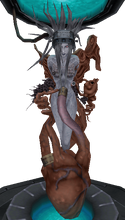
Jenova in Crisis Core -Final Fantasy VII-.
A dormant Jenova appears as a gray-skinned woman (shown as blue-skinned in Final Fantasy VII, or only appearing blue through its container in the Mako Reactor on Mt. Nibel in other games). Although Jenova appears feminine its gender is ambiguous, being an extra-terrestrial lifeform whom the Cetra never refer to with a feminine pronoun; Jenova is known as "calamity from the skies" in the legends, and in Final Fantasy VII Ifalna refers to Jenova with either "it" or "he" depending on the version of the game.
Jenova is bare (other than what appears to be an external biological system), with something resembling a heart at its feet. Connected to the heart-like organ are a number of tubes that reach to different parts of the body, the largest of which, pinker in color and similar to an umbilical cord, inserts into its abdomen (or in Final Fantasy VII, an apparently empty space in its abdomen). On its back Jenova has appendages along with what resembles a wing protruding from its left, and a stub of a wing from its right.
Jenova has long silver hair parted through the center. Its left eye glows red and it has no right eye, often being covered by hair. Jenova's headgear links to her container and has an inscription which has had a different message between different depictions of the scene. Above the headgear, an exposed brain lies within Jenova's cranium.
As Jenova bears female anatomy the body has two breasts, the right of which has what appears to be a nipple resembling an eyeball. The pubic area is obscured by the tube from the abdomen.
Jenova Doll
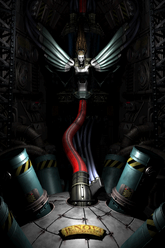
Jenova Doll in Final Fantasy VII.
At the Nibel Reactor Jenova's container is covered by what has been referred to as the "Jenova Cover" or "Jenova Doll". The effigy is a presumably man-made metal construct that resembles the torso of an angel that obscures Jenova while the wings cover the side of the container. Presumably connected to the roof are cables bearing the appearance of golden hair, offering cover to the higher areas of the container.
A tube links from the chamber's entrance to the cover's mid-point, possibly meant to resemble Jenova who has a similar tube. Whereas Jenova's tube leads to a heart-like organ, the area the cover's pipe leads to has tubes that resemble ventricles. The tube linking to the cover can be used as a path to reach the container. At the entrance to the chamber lies a sign reading "JENOVA."
Nature
Jenova's genetic structure is a two-way conduit: it can both take in the traits of its prey, and insert its own genes to turn other organisms into violent monsters. Once Jenova lands upon a planet it will destroy every form of life it finds. Jenova can absorb its prey's memories and form, hiding as their loved ones to destroy them.
As stated in Professor Hojo's Jenova Reunion Theory, once Jenova's cells have been separated from the main body they will seek to reunite. If they are inside a host body they can influence its mind and body to join the Reunion—sometimes so severely the host organism is killed. For an unknown reason organisms affected by Jenova often grow a single wing capable of flight and the pupils of the affected can change into a feline slit, though the rest of the eye remains unchanged.
Once Jenova has destroyed a planet it uses it as a vessel to travel the cosmos to another planet. Jenova's age is unknown, but since it can lay dormant for millennia if necessary, it might be older than the planet of Gaia itself.
Story
Arrival
Template:Sideicon Template:Sideicon Approximately two thousand years ago an alien creature landed on Gaia, having traveled through space on a meteorite. The impact created the North Crater. The creature approached the Cetra and used its mimic abilities to destroy them: those who were taken victim were infected with a virus (hinted to be genetic material from the creature itself) that mutated them into monsters. The creature would take the form of the fallen Cetra, and so get close enough to destroy their loved ones. Ifalna calls this process as Jenova giving the Cetra "the virus."
In this way, the creature destroyed most of the Cetra civilization. Their daughter race, the humans, hid away while the Cetra were almost eliminated. The few Cetra survivors banded to defeat the creature and quarantined it within the North Crater, where it would lie dormant for millennia. Despite their victory over the "calamity from the skies" the Cetra civilization was lost, and their numbers dwindled to almost nothing while humans spread over the Planet. As time wore on, humanity forgot about the creature and the Cetra fell into legend.
Rediscovery
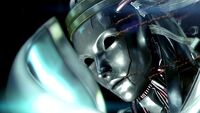
The Jenova effigy in Advent Children.
Two-thousand years later almost all memory of the creature has faded. The Shinra Electric Power Company rules the Planet with Mako energy, but is ever seeking a more efficient way to harvest it. The Cetra legend of the Promised Land piqued their interest, and the company delved into research into the race that was thought long extinct.
Approximately 30 years before the main events of Final Fantasy VII, Professor Gast Faremis exhumed the alien creature's remains and mistakenly identified it as a Cetra, naming it Jenova. The Jenova Project became an effort by a number of Shinra scientists to use Jenova's cells to create a human-Cetra hybrid who would lead them to the Promised Land.
Shinra was, of course, unsuccessful at creating a Cetra with Jenova's cells, but those treated with the cells proved to be super-soldiers, which led to the members of SOLDIER, Shinra's elite military force, being injected with the cells, as well. Sephiroth, Genesis Rhapsodos, and Angeal Hewley were born from the project during its first stages when Shinra was still trying to create a Cetra. Most of the early research took place in Nibelheim's Shinra Mansion, and Jenova was contained within the Mako Reactor at Mt. Nibel.
Sephiroth's "mother"
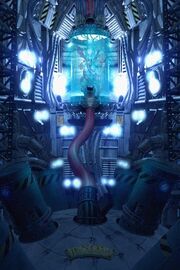
Jenova's tank in the Nibelheim Reactor.
Sephiroth, the ultimate SOLDIER who was directly infused with Jenova's cells in the fetal stage, was not told of his role in the Jenova Project. His biological father, Professor Hojo, told the young Sephiroth his mother's name was "Jenova" and that she died giving birth to him. His real mother being Lucrecia Crescent, it is unknown why Hojo chose to fabricate Sephiroth's parentage.
Many years later, Sephiroth was sent to the Nibel Reactor along with a fellow SOLDIER First Class Zack Fair and an infantry soldier named Cloud Strife, only to find it filled with Mako-infused mutants, ordinary humans infused with such high levels of Mako they had mutated. Suspecting his origins may be similar, Sephiroth's suspicions are confirmed when Genesis (who had deserted and rebelled against Shinra at that time) tells him the nature of the Jenova project and how he (Sephiroth) was the "perfect monster" to come out of it. Wanting to learn more, Sephiroth ventured into the Shinra Mansion's basement to read about the Jenova Project. The strain of these discoveries pushed him into insanity.
Believing himself a descendant of the Cetra whom the humans had "betrayed" Sephiroth went on a killing spree. He burned Nibelheim to the ground and returned to the reactor to collect his "mother." Due to being mortally wounded by Cloud, Sephiroth could only take Jenova's head before falling into the Lifestream below the reactor.
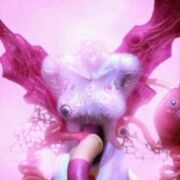
A headless Jenova in Shinra HQ.
Shinra forces took over the reactor and gathered the survivors of the massacre (sparing the local guide girl Tifa, who had been saved by her martial arts instructor Zangan) for Professor Hojo who would inject them with Jenova cells to test his Jenova Reunion Theory, thus creating the Sephiroth Clones, people whose psyches would be overriden by Sephiroth's will due to the Jenova cells in their bodies. Sephiroth was declared dead, and Jenova's headless remains were taken to Midgar and placed in Hojo's lab in Shinra Headquarters.
Due to the Jenova cells present in his body the Lifestream couldn't absorb Sephiroth completely. His will remained sentient and learned everything about Jenova, the Cetra, and the circle of life, formulating a plan to be reborn as a god to rule the Planet. Sephiroth's will overpowered Jenova's, and he gained the ability to exert his influence on those infected with the creature's cells, thus facilitating his plan to have them bring the Black Materia to him that would allow him to use the ultimate black magic spell.
In Sephiroth's form
Five years after the Nibelheim Incident Sephiroth puts his plans into action by taking control of Jenova's main body in Shinra Headquarters, morphing it into a vessel in his likeness, murdering soldiers until reaching the top of the building and impaling President Shinra. From there, Jenova escapes into the outside world. Cloud and his party chase "Sephiroth" across the Planet unaware it is Jenova under Sephiroth's control. Cloud follows Sephiroth to exact revenge for Nibelheim's torching, but on subconscious level is being guided by the Jenova cells inside him, as unbeknownst to him he is also a "Sephiroth Clone," albeit considered a failed one by Hojo. Several times throughout the party's journey the cells make him mentally unstable, and Sephiroth ultimately exerts his control over Cloud to make him hand over the Black Materia.
As the party follows "Sephiroth's" trail they run into pieces of Jenova he uses to hinder their pursuit and to keep them from discovering the truth. The first piece encountered, described as Jenova's arm, transforms into Jenova∙BIRTH and is fought on the cargo ship. Jenova∙LIFE manifests as Sephiroth when he murders the last Cetra, Aeris Gainsborough, at the altar in the Forgotten Capital. A third battle with Jenova occurs in the Whirlwind Maze with Jenova∙DEATH.
As Cloud and his friends defeat the last of Jenova's original body Cloud realizes that what they had been pursuing wasn't the real Sephiroth. The party finds Sephiroth crystallized in hibernation and under his control, Cloud relinquishes the Black Materia, allowing Sephiroth to summon Meteor. Sephiroth's plan is to wound the Planet so greatly the Lifestream would be summoned to heal the area allowing him to absorb it and become a god-like being.
Cloud recovers and throws off Sephiroth's influence and together with his party descends into the Northern Cave to defeat him. Before the final battle they fight Jenova∙SYNTHESIS, a form of Jenova composed of its remaining cells—this form is considered the creature's true form. Once it is defeated the party reaches an evolved Sephiroth and defeats him.
Remnants
Template:Sideicon
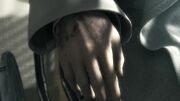
Geostigma.
Even with its main body destroyed Jenova's cells remained within the Lifestream and infected thousands who came into contact with them during the time Lifestream washed over the Planet to help destroy the Meteor Sephiroth had summoned. The infection with Jenova cells manifests as the plague Geostigma caused by the body overcompensating to try to eliminate the cells, leading to the development of sores and scars. Not fully diluted in the Lifestream, Sephiroth manifest his remnants into being: Kadaj, Loz and Yazoo.
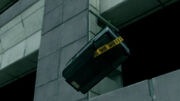
Jenova's remains in a sealed box.
The trio is compelled to find physical remains of Jenova to evoke a second Reunion to restore Sephiroth. Unbeknown to them Rufus Shinra holds Jenova's remains all along, having had his Turks retrieve them from the North Crater. When Rufus reveals his ruse he attempts to discard the remains, but Kadaj salvages them. After being defeated by Cloud, Kadaj absorbs the Jenova cells and Sephiroth is reborn in his body.
During his fight with Cloud, Sephiroth unveils his intentions to assimilate the Planet and journey to another world to repeat Jenova's work prior to arriving on the Planet. Sephiroth is defeated and Kadaj is left on the verge of death. Aerith's Great Gospel brings a healing rain upon Midgar and Edge, curing those suffering from Geostigma while Sephiroth's remnants cease to be. Due to Jenova's high adaptability and previous ability to survive, whether or not this is the true end of Jenova is unknown.
Gameplay
In Final Fantasy VII Jenova is fought four times. Jenova∙BIRTH is fought on the Cargo Ship. Jenova∙LIFE is fought in the Forgotten Capital at the end of Part I. Jenova∙DEATH is fought at the Whirlwind Maze, and Jenova∙SYNTHESIS is fought at the end of the game in the depths of Northern Cave.
Creation and development
According to the Final Fantasy VII Ultimania Omega, in an early version of the Final Fantasy VII script the fact the party is chasing Jenova rather than Sephiroth was made more explicit. During the party's confrontation with Jenova in Sephiroth's form on the cargo ship, "Sephiroth" would open his cape to shoot out a piece of Jenova, its hand. The Sephiroth Clones were not individual people infected with Jenova's cells but pieces of Jenova floating in air hiding under cloaks in the shapes of people. Each piece was named to be either its hand, thumb, or heart; this is why Cloud refers to Jenova∙BIRTH as the "arm" of Jenova upon its defeat. There were also two more boss fights: one between Cosmo Canyon and Nibelheim, and one in the Temple of the Ancients.
It has been suggested from the material present in the Ultimania Omega that rather than there being several Black Capes, there was just one, Jenova, who was cutting off bits of its body as it journeyed towards Sephiroth until all that remains is a heart. In the original version the party would catch up with the Black Cape in the Whirlwind Maze, and the figure would remove the hood to show it has no face, and then take off the cloak to show it is nothing but Jenova's heart floating midair, the final piece, which would then transform into a monster.
Final Fantasy VII Ultimania Omega[1] goes further to reveal that in the game's early plans Jenova wasn't an extraterrestrial being, but rather, a certain region of the human brain, or genes. The name "Jenova" was supposed to have originated from a book written by the Cetra. The element "Jenova" wasn't meant to surface under normal conditions, but rarely people were born in whom "Jenova" awakened naturally. The Jenova element could have been awakened through artificial means by exposing the person to Mako energy. The book of Jenova was said to have been written by the Cetra and known in the legends as both the "Book of God" and the "Book of the Devil" detailing everything unknown of the human brain (or genes).
"Thaumaturge" was a name given to those whose Jenova had awakened, used to denote those with special senses ordinary humans lack, regardless whether the abilities were innate (Aerith) or acquired (Sephiroth). Thaumaturge's abilities varied but they shared a common ability to be drawn to and sense one another. Those especially skilled were even sensitive to the thoughts of others. The Turks were planned to be experts at searching out the Thaumaturge.
In Final Fantasy VII: Advent Children, though Jenova's remains are referred to as "Jenova's head," the film's staff have stated the remains are merely random clusters of its cells and the term "head" was used due to a lack of an official term, and it stuck. The staff ensured the cloaked Rufus was never shown to move his left hand leaving viewers to presume he was injured, but the intention was that Rufus was gripping onto Jenova. During development, an early idea tossed around was that Kadaj would eat the Jenova cells to complete Sephiroth's reunion.[2]
Musical themes
Jenova has two signature themes in Final Fantasy VII. One is "J-E-N-O-V-A," played in fights with Jenova∙BIRTH and Jenova∙DEATH, in the fight against Hojo, and also in the stairway at the end of the game. The second track is "Jenova Absolute," heard during the fight with Jenova∙SYNTHESIS.
In the fight against Jenova∙LIFE, "Aeris's Theme" plays instead.
Other appearances
Final Fantasy Record Keeper
Template:Sideicon Jenova's boss forms appear an enemies in Final Fantasy Record Keeper.
Gallery
Etymology and symbolism
Jenova's name is a portmanteau of "Jehovah" and "Nova." "Jehovah" is a widely-accepted romanization of the ineffable Hebrew name 'יהוה', the covenantal name of the Abrahamic God. Nova is from the Latin feminine adjective for "new." Thus, Jenova's name means "New God," a point of symbolic significance, although this connection is not seen in the game.
Nova means "new" in Latin. A nova is a cataclysmic nuclear explosion caused by the accretion of hydrogen onto the surface of a white dwarf star. Supernovae are extremely luminous and cause a burst of radiation that often briefly outshines an entire galaxy, before fading from view over several weeks or months. During the 16th century, astronomer Tycho Brahe observed the supernova SN 1572 in the constellation Cassiopeia, describing it in his book De stella nova (Latin for "concerning the new star"), giving rise to the name nova. Given Jenova's association with planetary and universal themes, this may or may not be a coincidence.
The "jen" segment may hint at "genetics," a theme within the game. In this way, the name can be interpreted as "gene-nova."
Jenova has also been known as the "calamity from the skies." Calamity is an event that brings terrible loss, lasting distress or a severe affliction.
All of these combine to form a name which alludes to planetary catastrophe (Meteor), genetic traits and experiments (Hojo's creations, Aeris's Cetra genes, Jenova's genetic "children") and the birth of a new god (Sephiroth), making it appropriate.
Sephiroth being Jenova's "son," as well as the implication throughout Final Fantasy VII that he had become one and the same as her, may refer to the Christian belief that Jesus Christ is the Son of God, yet also via the blessed trinity one and the same with God the Father and God the Holy Spirit.
Final Fantasy VII draws heavily from the Lurian Kabalā (Jewish Mysticism), a medieval Jewish variant of Gnosticism. Both Gnosticism and its Kabbalist branch proclaim that humans have inside their bodies a spark of divine light from the Absolute, which returns there upon death. This Absolute is an infinite wellspring of spiritual energy, knowledge, and goodness, mirroring the function of the Lifestream. The Kabbalah states the Absolute is the Judeo-Christian God, whereas early Gnostics believed him to be an incompetent or malicious false god known as the demiurge ("artisan" in ancient Greek) who merely believed himself the uncreated deity because he was shielded from the Absolute by his "mother," an emanation from the Absolute (known as an Aeon) who fell from the skies. This demiurge, trapped in the material world, cannot create anything good, and instead corrupts the sparks of light, just like Jenova's corruption of the Lifestream and of human beings.
Trivia
- Jenova only has a single line of dialogue throughout the entire Compilation credited to it. The line comes directly after the party defeats Jenova∙LIFE, and says, "Because‚ you are... a puppet" to Cloud. In the PlayStation version of the game, the line was: "Beacause, [sic] you are......a puppet".
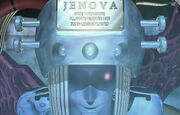
The plaque on Jenova's head.
- The inscription on Jenova's head can be read in a number of its appearances:
- In Final Fantasy VII, it reads:
MADE IN HONG KONG
ALL RIGHTS RESERVED 1996
SQUER COMPANY LIMITED - In Final Fantasy VII: Advent Children it reads:
|µ|-Era 19591010 Hakken
|µ|-Era 19670702 Fuuin - In Last Order -Final Fantasy VII-, it reads:
STRICT SECRECY
SCIENTIFIC INQUIRY SECTION
SHIN-RA COMPANY LIMITED
- In Final Fantasy VII, it reads:
- Jenova shares its trait as a cosmic world-consuming threat with the character Lavos, from the Square Co., Ltd. developed game Chrono Trigger.
- Jenova's ability to copy other organisms and its cells being semi-independent organisms to themselves, as well as its being an alien found sealed in the arctic are reminiscent of The Thing. Even Sephiroth's ability to assimilate Jenova's cells while maintaining his identity may have been based on it.
- Jenova Chen, designer of award-winning games such as Flower and Journey, took his name from the character Jenova and says that Final Fantasy VII is an influence to his work.
- The original idea of Jenova being a state of mind was later used in Parasite Eve and Xenogears, both also produced by Square.
- One of the servers of Final Fantasy XIV is named Jenova.
References
Template:FFVII Template:VIIAC

